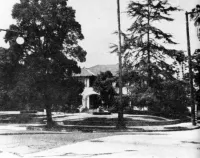Share what you know,
and discover more.
Share what you know,
and discover more.
Mar 04, 2022

-

- Charmaine Bantugan
Hattie McDaniel Residence
The Period Revival residence at 2203 South Harvard Boulevard was home to actress Hattie McDaniel beginning in the 1940s. Born in 1895 to two former slaves in Wichita, Kansas, McDaniel became the first black American to win an Academy Award in 1939. She was honored for her role as Mammy in Gone with the Wind. McDaniel identified as a bisexual woman and was married four times. In 1941, she moved into the Sugar Hill neighborhood of Los Angeles. At that time, Sugar Hill was popular among black celebrities (some notable residents include Joe Louis, Little Richard, Ray Charles, and "Sweet Daddy" Grace). Her house was designed by local architect Lester S. Moore in 1911. In 1949, white residents filed a lawsuit against McDaniel and other black homeowners in the Sugar Hill neighborhood because their property deeds forbade sale to non-Caucasians. After she was taken to court, a judge ruled in favor of McDaniel and other black homeowners on the grounds of the 14th Amendment. This amendment prohibits depriving individuals of life, freedom, and property without due process of law, and also prohibits the state from curtailing the privileges and protections of citizens. McDaniel died in 1952 at the age of 57. SIGNIFICANCE: McDaniels' victory in the Sugar Hill case and her substantial Hollywood career demonstrate the many intersections of class, race, gender, and sexuality that come to make up the identities of LGBTQ individuals of color. During her time in Hollywood, McDaniel was one of many Hollywood character actresses or leading ladies who were known for having non-conforming sexual or gender identities. Others include Judith Anderson, Tallulah Bankhead, Louise Brooks, Spring Byington, Constance Collier, Joan Crawford, Marlene Dietrich, Peggy Fears, Greta Garbo, Katherine Hepburn, Elissa Landi, Marjorie Min, Agnes Moorehead, Nita Naldi, Pola Negri, and Lilyan Tashman. Since McDaniels' 1939 Academy Award for Best Actress in a Supporting Role, only six black actresses had been similarly recognized as of 2015. None of these women have openly identified as a member of the LGBTQ community. Photo by Adrian Scott Fine/L.A. Conservancy
Hattie McDaniel Residence
The Period Revival residence at 2203 South Harvard Boulevard was home to actress Hattie McDaniel beginning in the 1940s. Born in 1895 to two former slaves in Wichita, Kansas, McDaniel became the first black American to win an Academy Award in 1939. She was honored for her role as Mammy in Gone with the Wind. McDaniel identified as a bisexual woman and was married four times. In 1941, she moved into the Sugar Hill neighborhood of Los Angeles. At that time, Sugar Hill was popular among black celebrities (some notable residents include Joe Louis, Little Richard, Ray Charles, and "Sweet Daddy" Grace). Her house was designed by local architect Lester S. Moore in 1911. In 1949, white residents filed a lawsuit against McDaniel and other black homeowners in the Sugar Hill neighborhood because their property deeds forbade sale to non-Caucasians. After she was taken to court, a judge ruled in favor of McDaniel and other black homeowners on the grounds of the 14th Amendment. This amendment prohibits depriving individuals of life, freedom, and property without due process of law, and also prohibits the state from curtailing the privileges and protections of citizens. McDaniel died in 1952 at the age of 57. SIGNIFICANCE: McDaniels' victory in the Sugar Hill case and her substantial Hollywood career demonstrate the many intersections of class, race, gender, and sexuality that come to make up the identities of LGBTQ individuals of color. During her time in Hollywood, McDaniel was one of many Hollywood character actresses or leading ladies who were known for having non-conforming sexual or gender identities. Others include Judith Anderson, Tallulah Bankhead, Louise Brooks, Spring Byington, Constance Collier, Joan Crawford, Marlene Dietrich, Peggy Fears, Greta Garbo, Katherine Hepburn, Elissa Landi, Marjorie Min, Agnes Moorehead, Nita Naldi, Pola Negri, and Lilyan Tashman. Since McDaniels' 1939 Academy Award for Best Actress in a Supporting Role, only six black actresses had been similarly recognized as of 2015. None of these women have openly identified as a member of the LGBTQ community. Photo by Adrian Scott Fine/L.A. Conservancy
Mar 04, 2022
Hattie McDaniel Residence
The Period Revival residence at 2203 South Harvard Boulevard was home to actress Hattie McDaniel beginning in the 1940s.Born in 1895 to two former slaves in Wichita, Kansas, McDaniel became the first black American to win an Academy Award in 1939. She was honored for her role as Mammy in Gone with the Wind.
McDaniel identified as a bisexual woman and was married four times. In 1941, she moved into the Sugar Hill neighborhood of Los Angeles.
At that time, Sugar Hill was popular among black celebrities (some notable residents include Joe Louis, Little Richard, Ray Charles, and "Sweet Daddy" Grace). Her house was designed by local architect Lester S. Moore in 1911.
In 1949, white residents filed a lawsuit against McDaniel and other black homeowners in the Sugar Hill neighborhood because their property deeds forbade sale to non-Caucasians.
After she was taken to court, a judge ruled in favor of McDaniel and other black homeowners on the grounds of the 14th Amendment. This amendment prohibits depriving individuals of life, freedom, and property without due process of law, and also prohibits the state from curtailing the privileges and protections of citizens.
McDaniel died in 1952 at the age of 57.
SIGNIFICANCE:
McDaniels' victory in the Sugar Hill case and her substantial Hollywood career demonstrate the many intersections of class, race, gender, and sexuality that come to make up the identities of LGBTQ individuals of color.
During her time in Hollywood, McDaniel was one of many Hollywood character actresses or leading ladies who were known for having non-conforming sexual or gender identities.
Others include Judith Anderson, Tallulah Bankhead, Louise Brooks, Spring Byington, Constance Collier, Joan Crawford, Marlene Dietrich, Peggy Fears, Greta Garbo, Katherine Hepburn, Elissa Landi, Marjorie Min, Agnes Moorehead, Nita Naldi, Pola Negri, and Lilyan Tashman.
Since McDaniels' 1939 Academy Award for Best Actress in a Supporting Role, only six black actresses had been similarly recognized as of 2015. None of these women have openly identified as a member of the LGBTQ community.
Photo by Adrian Scott Fine/L.A. Conservancy
Posted Date
Mar 03, 2022
Historical Record Date
Mar 04, 2022
Source Name
Los Angeles Conservancy
Delete Story
Are you sure you want to delete this story?











